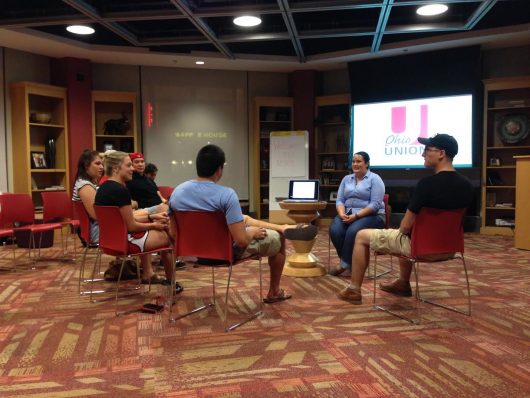
Students listen to Melissa Beard Jacob, intercultural specialist at Ohio State’s American Indian and Indigenous Student Initiatives, during a meeting for Native American students. Credit: Elizabeth Suarez | Multimedia Editor
For many Americans, much of what is known about Native American culture can be derived from a history lesson about past events, battles and wars that happened hundreds of years ago. However, one of the largest events in Native American history is happening right now.
Thousands of Native Americans have gathered at the Standing Rock Sioux Tribe Reservation, along the western North Dakota and South Dakota border to protect the future and ensure the history of the Sioux people continues, and some at Ohio State are standing in solidarity.
In what is being called the largest gathering of Native Americans in over 100 years, tribes from all over the country are attempting to stop the Dakota Access Pipeline from being built on the reservation. If built, the crude oil pipeline will run through what The Sioux consider sacred land and near the Missouri River, where the reservation receives its drinking water.
“Water is life, we need water to survive,” said Melissa Beard Jacob, intercultural specialist of American Indian and Indigenous Student Initiatives at OSU and member of the Sault Ste. Marie Tribe of Chippewa Indians.
Many tribes and activists present at the reservation have repeated the same words over the past month. Tensions escalated over the weekend as violence broke out between those protesting the pipeline and private security guards hired by Energy Transfer Partners, the company contracted by the U.S. Army Corp of Engineers to build the pipeline.
“History is repeating itself all over again. In the past violence has been used against native people for gain; it’s almost like we’re fighting the same battle again,” Jacob said.
Although multiple news sources reported that over the weekend Energy Transfer Partners bulldozers destroyed Sioux burial land, which are a valued part of the history of the culture, hope for the future remains high within the OSU Native American community.
“It’s great that kids, the younger generation, can look at what we’re doing today and see role models in leadership and hopefully they can emulate that and continue to change things for the better, as we’ve done for years in this nation,” said James Otworth, treasurer of the Native American and Indigenous Peoples Cohort at OSU.
The prospect of an oil pipeline running through four states has also called attention to environmentalists, especially because it has similarities to the Keystone XL Pipeline, which was a proposed seven miles longer than the Dakota Access Pipeline.
“If they build it, around 470,000 gallons of crude oil will be transported through this pipeline, and that has the potential to seriously affect the streams, the waterways, the groundwater of all of the surrounding states. It would potentially affect groundwater and drinking water for millions of people,” said Sophie Chang, a third-year in environment, economy, development & sustainability.
While this may be a Native American issue or an environmental issue for some, Jacob views it as much more.
“To me, this is not just a native issue, this is a human issue,” said Jacob.
The Native American and Indigenous Peoples Cohort at OSU plans to hold an event in solidarity with the Standing Rock Sioux Tribe in the upcoming weeks.


